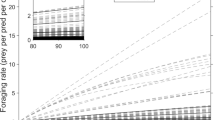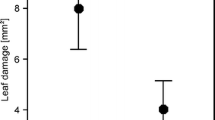Abstract
Induced prey defenses can be costly. These costs have the potential to reduce prey survival or reproduction and, therefore, prey population growth. I estimated the potential for predators to suppress populations of pea aphids (Acyrthosiphon pisum) in alfalfa fields through the induction of pea aphid predator avoidance behavior. I quantified (1) the period of non-feeding activity that follows a disturbance event, (2) the effect of frequent disturbance on aphid reproduction, and (3) the frequency at which aphids are disturbed by predators. In combination, these three values predict that the disturbances induced by predators can substantially reduce aphid population growth. This result stems from the high frequency of predator-induced disturbance, and the observation that even brief disturbances reduce aphid reproduction. The potential for predators to suppress prey populations through induction of prey defenses may be strongest in systems where (1) predators frequently induce prey defensive responses, and (2) prey defenses incur acute survival or reproductive costs.



Similar content being viewed by others
References
Anholt BR (1997) How should we test for the role of behaviour in population dynamics? Evol Ecol 11:633–640
Beckerman A, Benton TG, Ranta E, Kaitala V, Lundberg P (2002) Population dynamic consequences of delayed life-history effects. Trends Ecol Evol 17:263–269
Caillaud MC, Via S (2000) Specialized feeding behavior influences both ecological specialization and assortative mating in sympatric host races of pea aphids. Am Nat 156:606–621
Campbell A, Mackauer M (1977) Reproduction and population growth of the pea aphid under laboratory and field conditions. Can Entomol 109:277–284
Chapman RF (1998) The insects: structure and function, 4th edn. Cambridge University Press, Cambridge
Dill LM, Fraser AHG, Roitberg BD (1990) The economics of escape behavior in the pea aphid, Acyrthosiphon pisum. Oecologia 83:473–478
Dixon AFG (1998) Aphid ecology: an optimization approach, 2nd edn. Chapman and Hall, London
Feller W (1966) An introduction to probability theory and its applications. Wiley, New York
Gilbert JJ (1999) Kairomone-induced morphological defenses in rotifers. In: Tollrian R, Harvell CD (eds) The ecology and evolution of inducible defenses. Princeton University Press, Princeton, pp 127–141
Heimpel GE, Mangel M, Rosenheim JA (1998) Effects of time limitation and egg limitation on lifetime reproductive success of a parasitoid in the field. Am Nat 152:273–289
Karban R, Baldwin IT (1997) Induced responses to herbivory. University of Chicago Press, Chicago
Kleinbaum DG, Klein M (2005) Survival analysis: a self-learning text, 2nd edn. Springer, Berlin Heidelberg New York
Kouame KL, Mackauer M (1992) Influence of starvation on development and reproduction in apterous virginoparae of the pea aphid, Acyrthosiphon pisum. Can Entomol 124:87–95
Kuhlmann H-W, Kusch J, Heckmann K (1999) Predator-induced defenses in ciliated protozoa. In: Tollrian R, Harvell CD (eds) The ecology and evolution of inducible defenses. Princeton University Press, Princeton, pp 142–159
Lima SL (1998a) Nonlethal effects in the ecology of predator–prey interactions. Bioscience 48:25–34
Lima SL (1998b) Stress and decision making under the risk of predation: recent developments from behavioral, reproductive, and ecological perspectives. Adv Study Behav 27:215–290
Lima SL, Dill LM (1990) Behavioral decisions made under the risk of predation: a review and prospectus. Can J Zool 68:619–640
Losey JE, Denno RF (1998) Positive predator–predator interactions: enhanced predation rates and synergistic suppression of aphid populations. Ecology 79:2143–2152
Mackay PA, Wellington WG (1975) A comparison of the reproductive patterns of apterous and alate virginoparous Acyrthosiphon pisum (Homoptera: Aphididae). Can Entomol 107:1161–1166
McLean DL, Kinsey MG (1969) Probing behavior of the pea aphid, Acyrthosiphon pisum. IV. Effects of starvation on certain probing activities. Ann Entomol Soc Am 62:987–994
McPeek MA, Peckarsky BL (1998) Life histories and the strengths of species interactions: combining mortality, growth, and fecundity effects. Ecology 79:867–879
Nelson E, Rosenheim J (2006) Encounters between aphids and their predators: the relative frequencies of disturbance and consumption. Entomol Exp Appl 118:211–219
Nelson E, Matthews C, Rosenheim J (2004) Predators reduce prey population growth by inducing changes in prey behavior. Ecology 85:1853–1858
Preisser EL, Bolnick DI, Benard MF (2005) Scared to death? The effects of intimidation and consumption in predator–prey interactions. Ecology 86:501–509
Riessen HP, Sprules WG (1990) Demographic costs of antipredator defenses in Daphnia pulex. Ecology 71:1536–1546
Risebrow A, Dixon AFG (1987) Nutritional ecology of phloem-feeding insects. In: Slansky F, Rodriguez JG (eds) Nutritional ecology of insects, mites, spiders, and related invertebrates. Wiley, New York, pp 421–448
Roitberg BD, Myers JH (1979) Behavioural and physiological adaptations of pea aphids (Homoptera: Aphididae) to high ground temperatures and predator disturbance. Can Entomol 111:515–519
Roitberg BD, Myers JH, Frazer BD (1979) The influence of predators on the movement of apterous pea aphids between plants. J Anim Ecol 48:111–122
Rotheray GE (1989) Aphid predators: insects that eat greenfly. Richmond Pub. Co. Slough
Roy HE, Pell JK, Clark SJ, Alderson PG (1998) Implications of predator foraging on aphid pathogen dynamics. J Invertebr Pathol 71:236–247
SAS (1994) JMP statistics and graphics guide: version 3. SAS Institute, Cary
Schmitz OJ, Suttle KB (2001) Effects of top predator species on direct and indirect interactions in a food web. Ecology 82:2072–2081
Schoener TW (1986) Mechanistic approaches to community ecology: a new reductionism? Am Zool 26:81–106
Sih A (1987) Predators and prey lifestyles: an evolutionary and ecological overview. In: Kerfoot WC, Sih A (eds) Predation: direct and indirect impacts on aquatic communities. University Press of New England, Hanover, pp 203–224
Sih A (1994) Predation risk and the evolutionary ecology of reproductive behaviour. J Fish Biol 45:111–130
Sih A, Englund G, Wooster D (1998) Emergent impacts of multiple predators on prey. Trends Ecol Evol 13:350–355
Smith RH, Sibly RM (1985) Behavioural ecology and population dynamics: towards a synthesis. In: Sibly RM, Smith RH (eds) Behavioural ecology: ecological consequences of adaptive behaviour: the 25th symposium of the British Ecological Society, Reading, 1984. Blackwell Scientific, Oxford Oxfordshire, pp 577–591
Snyder WE, Ives AR (2003) Interactions between specialist and generalist natural enemies: parasitoids, predators, and pea aphid biocontrol. Ecology 84:91–107
Spitze K (1992) Predator-mediated plasticity of prey life history and morphology: Chaoborus americanus predation on Daphnia pulex. Am Nat 139:229–247
Tamaki G, Halfhill JE, Hathaway DO (1970) Dispersal and reduction of colonies of pea aphids by Aphidius smithi (Hymenoptera: Aphidiidae). Ann Entomol Soc Am 63:973–980
Tollrian R, Dodson SI (1999) Inducible defenses in cladocera: constraints, costs, and multipredator environments. In: Tollrian R, Harvell CD (eds) The ecology and evolution of inducible defenses. Princeton University Press, Princeton, pp 177–202
Tollrian R, Harvell CD (1999) The ecology and evolution of inducible defenses. Princeton University Press, Princeton
University of California (1985) Integrated pest management for alfalfa hay. University of California, Division of Agriculture and Natural Resources, Oakland
Walls M, Ketola M (1989) Effects of predator-induced spines on individual fitness in Daphnia pulex. Limnol Oceanogr 34:390–396
Werner EE (1992) Individual behavior and higher-order species interactions. Am Nat 140:S5–S32
Wilkinson TL, Douglas AE (1995) Aphid feeding, as influenced by disruption of the symbiotic bacteria: an analysis of the pea aphid (Acyrthosiphon pisum). J Insect Physiol 41:635–640
Acknowledgments
Thanks to Doug Tallamy for suggesting pea aphids as a study system. The development and execution of the project benefited from discussions with the UC Davis Plant–Insect Group, the Rosenheim Lab Group, and Kai Cha. In the field, I received assistance from Chris Matthews, Kelly Lister, and Kate Chmiel, and our activities were kindly accommodated by Mark Rubio and the UC Davis Animal Science farm crew. I am grateful for the financial support I received from the UC Davis Center for Population Biology, NRI Competitive Grants Program/USDA grants 96-35302-3816 and 2001-35302-10955 to Jay Rosenheim, the San Francisco ARCS Foundation, and Kai Cha. The Rosenheim Lab Group, Rick Karban, Sharon Lawler, and Andy Sih induced changes in this paper by commenting on drafts of the manuscript. The experiments reported here comply with the current USA law.
Author information
Authors and Affiliations
Corresponding author
Additional information
Communicated by Oswald Schmitz.
Electronic supplementary material
Rights and permissions
About this article
Cite this article
Nelson, E.H. Predator avoidance behavior in the pea aphid: costs, frequency, and population consequences. Oecologia 151, 22–32 (2007). https://doi.org/10.1007/s00442-006-0573-2
Received:
Accepted:
Published:
Issue Date:
DOI: https://doi.org/10.1007/s00442-006-0573-2




